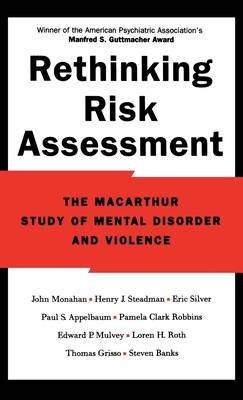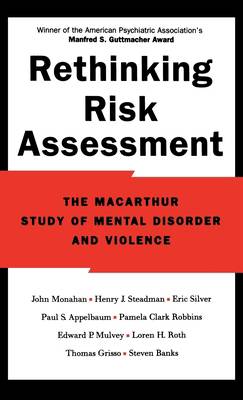
- Afhalen na 1 uur in een winkel met voorraad
- Gratis thuislevering in België vanaf € 30
- Ruim aanbod met 7 miljoen producten
- Afhalen na 1 uur in een winkel met voorraad
- Gratis thuislevering in België vanaf € 30
- Ruim aanbod met 7 miljoen producten
Zoeken
Rethinking Risk Assessment
The MacArthur Study of Mental Disorder and Violence
John (Henry Grace Doherty Professor of Law, Psychology, and Lega, Henry J. Steadman, Eric (Assistant Professor in the Department of Sociology, Assist, Paul S. (Zeleznik Professor and Chair of Psychiatry, Zeleznik Pr, Pamela Clark Robbins, Edward P. (Associate Professor of Psychiatry, Associate Professo, Loren H. (Professor and Vice President, Professor and Vice Presi, Thomas (Professor of Psychiatry, Professor of Psychiatry, Univer, Steven Banks
Hardcover | Engels
€ 143,45
+ 286 punten
Omschrijving
The presumed link between mental disorder and violence has been the driving force behind mental health law and policy for centuries. Legislatures, courts, and the public have come to expect that mental health professionals will protect them from violent acts by persons with mental disorders. Yet for three decades research has shown that clinicians' unaided assessments of "dangerousness" are barely better than chance. Rethinking Risk Assessment: The MacArthur Study of Mental Disorder and Violence tells the story of a pioneering investigation that challenges preconceptions about the frequency and nature of violence among persons with mental disorders, and suggests an innovative approach to predicting its occurrence. The authors of this massive project -- the largest ever undertaken on the topic -- demonstrate how clinicians can use a "decision tree" to identify groups of patients at very low and very high risk for violence. This dramatic new finding, and its implications for the every day clinical practice of risk assessment and risk management, is thoroughly described in this remarkable and long-anticipated volume. Taken to heart, its message will change the way clinicians, judges, and others who must deal with persons who are mentally ill and may be violent will do their work.
Specificaties
Betrokkenen
- Auteur(s):
John (Henry Grace Doherty Professor of Law, Psychology, and LegaHenry J. SteadmanEric (Assistant Professor in the Department of Sociology, AssistPaul S. (Zeleznik Professor and Chair of Psychiatry, Zeleznik PrPamela Clark RobbinsEdward P. (Associate Professor of Psychiatry, Associate ProfessoLoren H. (Professor and Vice President, Professor and Vice PresiThomas (Professor of Psychiatry, Professor of Psychiatry, UniverSteven Banks
- Uitgeverij:
Inhoud
- Aantal bladzijden:
- 208
- Taal:
- Engels
Eigenschappen
- Productcode (EAN):
- 9780195138825
- Verschijningsdatum:
- 1/03/2001
- Uitvoering:
- Hardcover
- Formaat:
- Genaaid
- Afmetingen:
- 142 mm x 213 mm
- Gewicht:
- 385 g

Alleen bij Standaard Boekhandel
+ 286 punten op je klantenkaart van Standaard Boekhandel
Beoordelingen
We publiceren alleen reviews die voldoen aan de voorwaarden voor reviews. Bekijk onze voorwaarden voor reviews.











